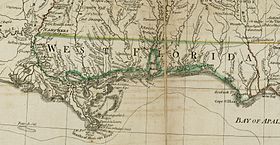This article needs additional citations for verification. (June 2023) |
The Battle at The Village, also known as the Second Battle of Mobile, fought on January 7, 1781, was a failed British attempt to recapture a Spanish fortification at "The Village," during the American Revolutionary War. The attack was led by Waldecker Colonel Johann von Hanxleden who was killed in the attempt.
| Battle at The Village | |||||||
|---|---|---|---|---|---|---|---|
| Part of the Gulf Coast campaign of the American Revolutionary War | |||||||
 Detail from a 1776 map showing West Florida | |||||||
| |||||||
| Belligerents | |||||||
|
| |||||||
| Commanders and leaders | |||||||
|
| ||||||
| Strength | |||||||
| 190 troops | |||||||
| Casualties and losses | |||||||
|
| ||||||
Location within modern-day North America | |||||||
Background
editAfter Spain declared war on Great Britain in 1779, Bernardo de Gálvez, the governor of Louisiana, immediately began offensive operations to gain control of neighboring West Florida, which included parts of today's Louisiana, Mississippi, and Alabama. In September 1779 he gained complete control over the lower Mississippi River by capturing Fort Bute and shortly afterwards obtaining the surrender of the remaining enemy forces in the region following the Battle of Baton Rouge. He followed up these successes with the capture of Mobile on March 14, 1780, following a brief siege. (In the spring of 1781, Gálvez would go on to capture Pensacola, West Florida's administrative capital.)
After the victory in Mobile, the Spanish built an entrenched outpost on the east side of Mobile Bay. This outpost was designed to defend "The Village," a settlement that occupied the eastern ferry terminus on Mobile Bay for the main road between Mobile and Pensacola. When the British troops arrived on January 7, the outpost was manned by about 200 men of the Principe Regiment, under Ramón de Castro y Gutiérrez.
Prelude
editThe British garrison nearest to Mobile was in West Florida's capital, Pensacola. The commander, General John Campbell, had under his command about 500 men, composed mostly of men from the 16th and 60th Regiments, but also including some Waldecker grenadiers and some provincial militia. The British relations with the Creeks, Chickasaw, and Choctaw Indians were also relatively good. Hundreds of Choctaw warriors responded to British pleas for help and came to Mobile.[1]
Emboldened by the destruction of a Gálvez-led expedition against Pensacola by a hurricane in the fall of 1780, Campbell decided to attempt the recapture of Mobile.[2] On January 3, he dispatched an expedition of more than 700 men under Waldecker Colonel Johann von Hanxleden.[3]
Battle
editHanxleden's force arrived near the outpost late on January 6, and made a dawn attack the next morning. Forty of the Spaniards made a dash for a boat anchored nearby, but the British cut many of them down with a musket volley. Indians from the expedition then followed the Spaniards into the water to collect scalps. The remaining Spanish coolly opened fire on the British, killing Johann von Hanxleden and nineteen others. Ramón de Castro y Gutiérrez led a successful bayonet charge against 3 to 1 odds. The British troops then disengaged and retreated.[2]
Aftermath
editThe British retreated back to Pensacola, and made no further attempts against Mobile. Spanish authorities in Cuba dispatched additional forces to hold Mobile when they learned of the attack. With the death of Colonel Hanxleden, a favorite commander of General Campbell on the Gulf Coast, the British forces lost a major asset in terms of military capabilities and morale. Spanish Field Marshal Gálvez captured Pensacola later in the year, completing his conquest of West Florida. Ramón de Castro y Gutiérrez later used this experience for the defensive plans of San Juan, Puerto Rico, where he became Captain General in 1795, after the invasion of Trinidad in 1797. The English attacked San Juan a few months after Trinidad.
Legacy
editThe battlefield and the settlement of "The Village" have, in many ways, been lost to history. Though located near Village Point in Daphne, Alabama, the surrounding area has seen a heavy amount of residential development that has long since leveled the battlefield or any historical structures related to the settlement.
See also
editReferences
edit- ^ O'Brien, Greg (April 30, 2008). Pre-removal Choctaw history: exploring new paths. University of Oklahoma Press. pp. 125–126. ISBN 978-0-8061-3916-6. Retrieved March 25, 2011.
- ^ a b Nester (2004), p. 291
- ^ Hamilton (1897), p. 256
Bibliography
edit- Caughey, John Walton (1972). Bernardo de Gálvez in Louisiana, 1776-1783. Gretna, LA: Pelican. ISBN 978-0-911116-78-6. OCLC 539028.
- Marley, David (1998). Wars of the Americas: a chronology of armed conflict in the New World, 1492 to the present. Santa Barbara, CA: ABC-CLIO. ISBN 978-0-87436-837-6. OCLC 39024726.
- Hamilton, Peter Joseph (1897). Colonial Mobile: An Historical Study, Largely from Original Sources, of the Alabama-Tombigbee Basin from the Discovery of Mobile Bay in 1519 Until the Demolition of Fort Charlotte in 1821. New York: Houghton Mifflin. OCLC 9296191.
- Nester, William R (2004). The frontier war for American independence. Mechanicsburg, PA: Stackpole Books. ISBN 978-0-8117-0077-1. OCLC 52963301.
- Holmes, Jack D.L. (July 1976). "Alabama's Bloodiest Day of the American Revolution Counterattack at the Village, January 7, 1781" (PDF). Alabama Review. 29 (3): 207–219. Retrieved December 30, 2020.
